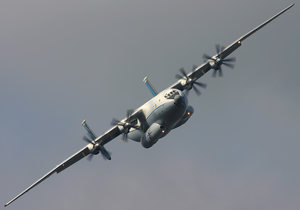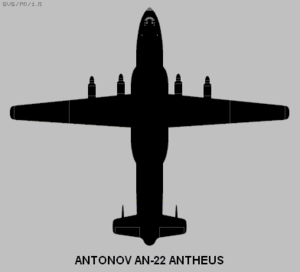| An-22 "Antei" | |
|---|---|
| Antonov An-22 | |
| Role | Strategic airlifter |
| Manufacturer | Antonov |
| Designer | Oleg Antonov |
| First flight | 27 February 1965 |
| Introduction | 1967 |
| Status | in active service |
| Primary users | Military Transport Aviation (Soviet Air Force) Aeroflot Antonov Airlines |
| Produced | 1966–1976 |
| Number built | 68 |
The Antonov An-22 "Antei" ([Ан-22 Антей] Error: {{Lang-xx}}: text has italic markup (help); [Ан-22 Антей] Error: {{Lang-xx}}: text has italic markup (help)[1]) (NATO reporting name "Cock") is a heavy military transport aircraft designed by the Antonov Design Bureau in the Soviet Union. Powered by four turboprop engines each driving a pair of contra-rotating propellers, the design was the first Soviet wide-body aircraft and remains the world's largest turboprop-powered aircraft to date. An-22 first appeared for public outside the Soviet Union at the 1965 Paris Air Show. Since then, the model saw extensive use in major military and humanitarian airlifts of the Soviet Union.
Design and development[]

First prototype of the An-22, pictured in 1991 at Gostomel Airport.
In the late 1950s the Soviet Union required a large military transport aircraft to supplement the Antonov An-8 and An-12s then entering service.[2] Originally known as the An-20, the model was a conventional multi-engined high-wing design.[2] In the early 1960s the Antonov bureau produced a wooden mock up at its Kiev workshops of what was designated the Model 100.[2] The prototype now designated the An-22 was rolled out 18 August 1964 and first flew on 27 February 1965.[2] The prototype was given the name Antheus and, after four-months of test flying, was displayed at the 1965 Paris Air Show.[2] Serial aircraft were built at the Tashkent State Aircraft Factory and the first military delivery was made to the Air Transport Wing at Ivanovo Airbase in 1969.[2]
The aircraft was designed as a strategic airlifter, designed specifically to expand the Soviet Airborne Troops' capability to land with their then-new BMD-1 armoured vehicles. The An-22 cargo hold can accommodate four BMD-1 compared to only one in the An-12.
It also has the capability to takeoff from austere, unpaved and short airstrips, allowing airborne troops to perform air-landing operations. This is achieved by four pairs of contra-rotating propellers, similar to those on the Tupolev Tu-114. The engines generate significant thrust, and produce a slipstream over the wings and large double-slotted flaps. The landing gear is ruggedized for rough airstrips, and, in early versions, tire pressures could be adjusted in flight for optimum landing performance, although that feature was removed in later models.
The An-22 follows traditional cargo transport design with a high-mounted wing allowing a cavernous cargo space of 33m in length and a usable volume of 639m³. The forward fuselage is fully pressurized and provides space for 5 to 8 crew and up to 28 passengers, but the cargo space is pressurized to only 3.55 PSI / 0.245 bar allowing for a lighter airframe. A door equipped with pressure bulkhead is located at frame 14, separating the cargo attendant's compartment from the main cargo compartment. This allows the rear cargo doors to be opened during flight for paratroops and equipment drop. Like the An-12, the aircraft has a circular fuselage section. The An-22 has set a number of payload and payload-to-height world records[citation needed].
The An-22 has the general appearance of an enlarged version of the earlier Antonov An-12 except that it is fitted with a twin tail. This gives the An-22 better engine-out performance, and reduces height restrictions for hangars. Also of note are large anti-flutter masses on the top of each tail.

Soviet 1965 post stamp showcasing the An-22 success at the Paris Air Show.
Only one production variant was built, the standard An-22[Clarification needed]. Prototypes, such as the one first featured at the 1965 Paris Air Show had fully glazed noses that lacked the nose mounted radar of production models. Those aircraft had the radar mounted below the right wheel well fairing, forward of the wheels. Antonov designated a variant with a modified electrical system and an additional augmented flight control system the An-22A but the designation was not used by the military.[2]
A proposed civil airliner version capable of seating 724 passengers on upper and lower decks was planned but wasn't constructed. (For comparison, a typical Boeing 747 can carry 400–500 passengers.)
Variants[]
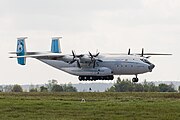
An-22 at Gostomel.
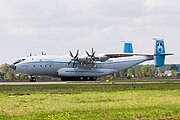
- An-22
- Three original were prototypes built at the Antonov facility in Kiev, with glass nose.
- An-22
- Initial production variant with external start system, 37 built at Tashkent.
- An-22A
- Improved variant with air-start capability, modified electrical system, and updated radio and navigation equipment, 28 built at Tashkent.
- An-22PZ
- Conversion of two An-22s to carry wing centre sections or outer wings of Antonov An-124 or An-225 externally above fuselage. Fitted with third centreline fin.[3]
Several other An-22 variants were projected and constructed by Antonov but never entered serial production, notably a nuclear-powered aircraft and a ballistic missile platform.
Operational history[]
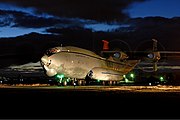
An-22 of the Russian Air Force in Migalovo.
The An-22 was originally built for the Soviet Air Force and Aeroflot (the state airline). Rearming from An-12 in the Air Force began in July 1974. Several Military Transport Aviation units were equipped. The 12th Mginsk Red Banner Military Transport Aviation Division (based at Migalovo) was one of the units which had its three regiments entirely equipped with the An-22s. Another unit that operated it was the 566th Solnechnogorsk Military Transport Aviation Regiment, which used the An-22 from 1970 to 1987.
An early use of the An-22 was to deliver Soviet humanitarian aid to earthquake-hit Peru in July 1970. One An-22 disappeared on 18 July during these relief flights. An-22s were also used to deliver Soviet military aid to Egypt and Syria during the Yom Kippur War in 1973, to Angola in 1975, and to Ethiopia in 1977.[4]
The An-22s from Migalovo were used for the initial deployment of the Soviet Airborne Troops (VDV) during the 1979 Soviet invasion in Afghanistan. One An-22 was shot down near Kabul on 28 October 1984.[5] In 1980, one An-22 crashed at Vnukovo Airport while two crashed at Migalovo (in 1992 and 1994).
In 1984, military An-22s were used to deliver Mi-8 helicopters to Ethiopia during drought relief operations.
In 1986 the aircraft of the 8th Military Air Transport Aviation Regiment from Migalovo were used to deliver materials for the Chernobyl disaster relief operation.
During 1987 the An-22s were used to deliver military equipment to Angola. A year later the military An-22s were used to deliver 15,000 tons and 1,000 personnel for the 1988 Spitak earthquake relief operation in Armenia.

View of an An-22 from behind.
The An-22 aircraft were often seen at the Le Bourget Air Show, and in 1988 delivered an engine from An-124 to the Farnborough Airshow.
In late 1980s, the An-22s were used to deliver Internal Troops to many regional conflicts during and after the breakup of the Soviet Union. In 1995 they deployed the Russian peacekeeping force from the 98th Guards Airborne Division during the Bosnian War.
Approximately 45 An-22s remained in service by the mid-1990s, mostly with the Russian Air Force, but these are slowly being replaced by the bigger turbofan-powered Antonov An-124. The remaining An-22s appear to be operated by an independent military transport aviation squadron at Migalovo.
Operators[]
According to unofficial sources, 7 An-22s were in use as of 2010: 6 in the Russian Air Force and one for civilian cargo duties with the Antonov Airlines; with additional 18 airplanes in storage.[6]
Military[]
Former[]
- 8th Military Transport Aviation Regiment[7]
- Other regiments
Current[]
- Russian Air Force 7 active[8]
Civil[]
Former[]
- Air Sofia (leased)
Current[]
- Antonov Airlines
As of August 2006, the single Antonov An-22 aircraft remains in cargo service with the Antonov Airlines.[9] The Antonov design bureau retained the three prototype aircraft for use as special cargo transports[2] Two aircraft were modified to carry An-124 wings above the fuselage.[2]
Incidents and Accidents[]
As of January 2011, there have been 9 hull losses with a total of 95 fatalities.[citation needed]
| Date | Registration | Location | Fatalities | Brief description |
|---|---|---|---|---|
| July 18, 1970 | СССР-09307 | atlantic near Keflavík International Airport, Iceland | all of 26 passengers + crew | humanitarian aid transport to Lima, Peru lost on radar 47 min after take off from Keflavík International Airport. |
| December 28, 2010 | RA-09343 | near Krasny Oktyabr (Tula Oblast, Russia) | 12/12 | RA-09343 of the Russian Air Force crashed killing all twelve crew. The aircraft was on a positioning flight from Voronezh Airport to Migalovo airbase.[11] The aircraft had been in storage since 2001 and was brought back into flying condition in January 2010.[12][13] |
Specifications (An-22)[]
Data from Jane's All The World's Aircraft 1982–83[14]
General characteristics
- Crew: 5–6
- Capacity: 29 passengers
- Payload: 80,000 kg (176,350 lb)
- Length: 57.9 m[15] (189 ft 11½ in)
- Wingspan: 64.40 m (211 ft 4 in)
- Height: 12.53 m (41 ft 1½ in)
- Wing area: 345 m² (3,713 ft²)
- Empty weight: 114,000 kg (251,325 lb)
- Max. takeoff weight: 250,000 kg (551,160 lb)
- Powerplant: 4 × Kuznetsov NK-12MA turboprops driving contra-rotating propellers, 11,186 kW (15,000 shp) each
Performance
- Maximum speed: 740 km/h (399 knots, 460 mph)
- Range: 5,000 km (2,700 nmi, 3,100 mi)with maximum payload, 10,950 km (5,905 nmi, 6,800 mi) with maximum fuel and 45,000 kg (99,200 lb) payload
Name discomfiture[]
The aircraft received the name Antaeus to symbolize its heavy-lift capabilities. However, the mythological character Antaeus was strong only as long as he remained in contact with the ground (his mother Earth), but once lifted into the air he became weak. This vulnerability in legend is how Hercules (also the name of an American cargo aircraft still in production) killed him.[16]
Gallery[]
See also[]
- Antonov An-12
- Airbus A400M
- Antonov An-70
- Douglas C-133
- Lockheed C-5 Galaxy
- List of military aircraft of the Soviet Union and the CIS
References[]
- ↑ named for the mythical Greek half-giant
- ↑ 2.0 2.1 2.2 2.3 2.4 2.5 2.6 2.7 2.8 Sebastian Zacharias (June 2001). "Antonov An-22 Antheus". p. pp.58–62. ISSN 1465-6337.
- ↑ Gordon, Komissarov and Komissarov Air International January 2006, pp. 35–36.
- ↑ Gordon, Komissarov and Komissarov Air International January 2006, pp. 36–37.
- ↑ Gordon, Komissarov and Komissarov Air International January 2006, p. 37.
- ↑ Ан-22 (Russian)
- ↑ accessed November 2011
- ↑ http://russianplanes.net/planelist/Antonov/An-22
- ↑ Flight International, 3–9 October 2006
- ↑ http://www.airwar.ru/enc/craft/an22.html
- ↑ "RA09343 Accident description". Aviation Safety Network. http://aviation-safety.net/database/record.php?id=20101228-0. Retrieved 1 January 2011.
- ↑ "Антонов Ан-22А Бортовой №: RA-09343" (in Russian). Russian Planes. http://russianplanes.net/EN/REGINFO/587. Retrieved 1 January 2011.
- ↑ "Giant Antonov An-22 cargo plane crashes in rural Russia". BBC News. 29 December 2010. Archived from the original on 26 January 2011. http://web.archive.org/web/20110126030748/http://www.bbc.co.uk/news/world-europe-12088525. Retrieved 2010-12-28.
- ↑ Taylor 1982, pp. 190–191.
- ↑ Gunston 1995, p. 27.
- ↑ ISBN 5020357502
- Alexander, Jean (1975). Russian Aircraft since 1910. London: Purnell Book Services.
- Gordon, Yefim; Komissarov, Dmitry; Komissarov, Sergei. "Antonov An-22: A Venerable Giant". pp. pp. 30–37.
- Gunston, Bill (1995). The Osprey Encyclopedia of Russian Aircraft 1875–1995. Osprey: London. ISBN 1-85532-405-9.
- Stroud, John (1968). Soviet Transport Aircraft since 1945. London: Putnam. ISBN 0-370-00126-5.
Further reading[]
- Pyotr Butowski, 'Air Power Analysis – Russian Federation Part 2' in International Air Power Review, Volume 13, Summer 2004, AIRtime Publishing Inc., Norwalk, CT.
- Goebel, Greg (2006-01-01). "The Antonov Giants". Air Vectors. Archived from the original on 12 August 2006. http://web.archive.org/web/20060812050412/http://www.vectorsite.net/avantgt.html. Retrieved 2006-06-28.
- "Antonov An-22 Antheus". airliners.net. Archived from the original on 18 June 2006. http://web.archive.org/web/20060618095347/http://www.airliners.net/info/stats.main?id=36. Retrieved 2006-06-28.
External links[]
| Wikimedia Commons has media related to Antonov An-22. |
- Walkaround An-22А RA-09309 at MAKS-2009, Second walk
- Walkaround Ан-22 at Monino Museum, Russia
- Airliners.net An-22
- AN-22 specifications compared next to other cargo charter aircraft
- Aeronautics.ru An-22
- 8th air transport air regiment (in Russian)
The original article can be found at Antonov An-22 and the edit history here.
